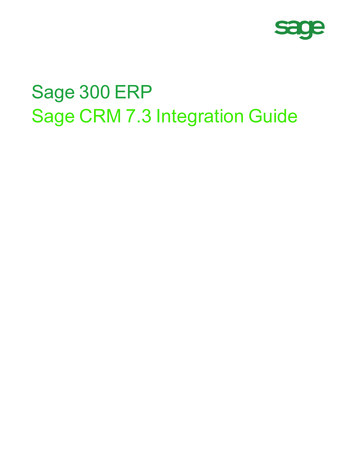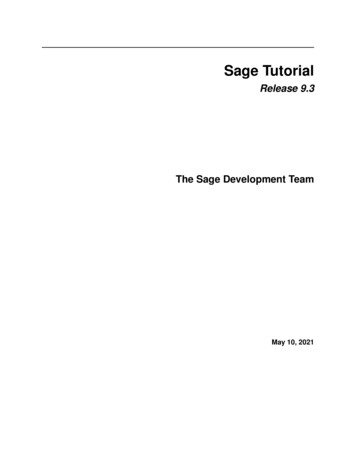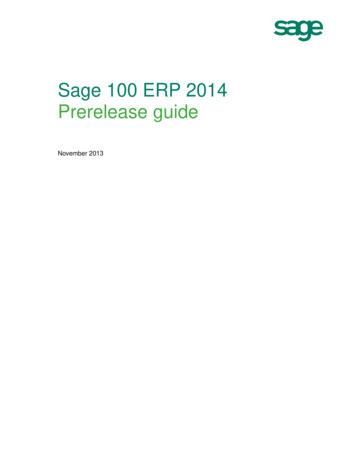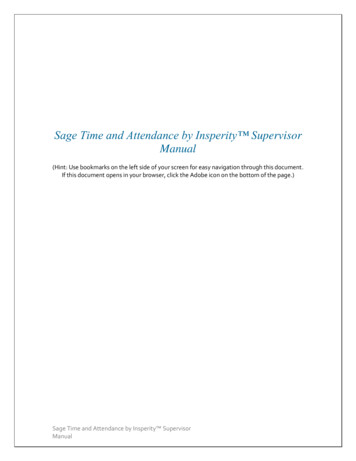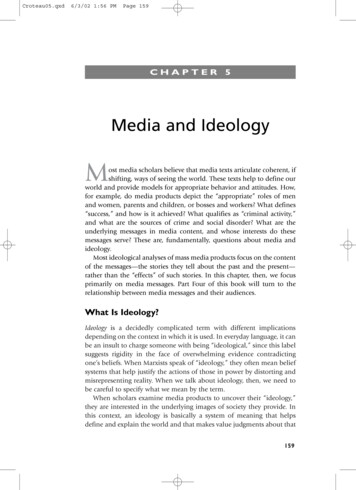
Transcription
Croteau05.qxd6/3/02 1:56 PMPage 159CHAPTER 5Media and IdeologyMost media scholars believe that media texts articulate coherent, ifshifting, ways of seeing the world. These texts help to define ourworld and provide models for appropriate behavior and attitudes. How,for example, do media products depict the “appropriate” roles of menand women, parents and children, or bosses and workers? What defines“success,” and how is it achieved? What qualifies as “criminal activity,”and what are the sources of crime and social disorder? What are theunderlying messages in media content, and whose interests do thesemessages serve? These are, fundamentally, questions about media andideology.Most ideological analyses of mass media products focus on the contentof the messages—the stories they tell about the past and the present—rather than the “effects” of such stories. In this chapter, then, we focusprimarily on media messages. Part Four of this book will turn to therelationship between media messages and their audiences.What Is Ideology?Ideology is a decidedly complicated term with different implicationsdepending on the context in which it is used. In everyday language, it canbe an insult to charge someone with being “ideological,” since this labelsuggests rigidity in the face of overwhelming evidence contradictingone’s beliefs. When Marxists speak of “ideology,” they often mean beliefsystems that help justify the actions of those in power by distorting andmisrepresenting reality. When we talk about ideology, then, we need tobe careful to specify what we mean by the term.When scholars examine media products to uncover their “ideology,”they are interested in the underlying images of society they provide. Inthis context, an ideology is basically a system of meaning that helpsdefine and explain the world and that makes value judgments about that159
Croteau05.qxd6/3/02 1:56 PMPage 160160 / Content: Media Representations of the Social Worldworld. Ideology is related to concepts such as worldview, belief system, andvalues, but it is broader than those terms. It refers not only to the beliefsheld about the world but also to the basic ways in which the world isdefined. Ideology, then, is not just about politics; it has a broader andmore fundamental connotation.When we examine the ideology of media, we are not so much interested in the specific activities depicted in a single newspaper, movie, orhit song as in the broader system of meaning of which these depictionsare a part. For ideological analysis, the key is the fit between the imagesand words in a specific media text and ways of thinking about, evendefining, social and cultural issues.As we will explore in the next chapter, media scholars are often interested in assessing how media content compares to the “real world.”Scholars are interested in the images of, say, women, or AfricanAmericans—and how these images may change over time—because theycontribute to the ways we understand the roles of these groups in society.In this case, the question is not whether such media images are “realistic”depictions because analysts of ideology generally perceive the definitionof the “real” as, itself, an ideological construction. Which aspects of whose“reality” do we define as the most real? Those that are the most visible?The most common? The most powerful? Instead of assessing the imagesand making some judgment about levels of realness, ideological analysisasks what these messages tell us about ourselves and our society.Politicians have long perceived mass media, both news and entertainment forms, as sites for the dissemination of ideology. That is one reasonwhy media are so frequently the subjects of political debate. Indeed,prominent politicians routinely identify mass media as a facilitator, andsometimes a source, of social problems. For example, on the campaigntrail in 2000, presidential candidate George W. Bush suggested that “darkdungeons of evil on the Internet” were partly to blame for school violence (Kornblut and Scales, 2000). And after the tragic shootings atColorado’s Columbine High School in 1999, politicians from across thepolitical spectrum focused on violent video games as one of the causesof the violence. Throughout the partisan debate in 1998 over PresidentClinton’s impeachment, Democrats blamed the news media for blowingthe scandal out of proportion, and Republicans criticized journalists forvilifying the Independent Counsel. And as the Internet expands, politicians continue to condemn the availability of sexually explicit materialonline and argue that unregulated speech and imagery on the Internetpose a threat to children’s safety and well-being. In addition, in the wakeof the April 1995 bombing of the Oklahoma City federal building,President Clinton identified extremists on talk radio as purveyors of
Croteau05.qxd6/3/02 1:56 PMPage 161Media and Ideology / 161hatred, implying that these radio hosts were disseminating a worldviewthat condoned violence. In 1995, then-Senate Majority Leader RobertDole focused his attention on the entertainment industry, condemningwhat he identified as the rampant sex, violence, and general antifamilytone of popular television, movies, and music. And former Secretary ofEducation William Bennett made a media splash in 1995 with his attackon media giant Time Warner for its distribution of “gangsta” rap.Virtually all forms of mass media—radio, television, movies, music,and the Internet—are standard targets, attacked by politicians from different political perspectives who have little doubt that the media areideological, selling certain messages and worldviews. Given that thesekinds of media criticism are often well received, there is good reason tobelieve that large numbers of the public also perceive the media aspurveyors of ideology—even if they don’t use the term. Media sell bothproducts and ideas, both personalities and worldviews; the notion thatmass media products and cultural values are fundamentally intertwinedhas gained broad public acceptance.“Dominant Ideology” Versus Cultural ContradictionsEven though mass media texts can be understood in ideologicalterms, as forms of communication that privilege certain sets of ideas andneglect or undermine others, unambiguous descriptions of media ideology remain problematic. Research on the ideology of media has includeda debate between those who argue that media promote the worldviewof the powerful—the “dominant ideology”—and those who argue thatmass media texts include more contradictory messages, both expressingthe “dominant ideology” and at least partially challenging worldviews.We prefer to think of media texts as sites where cultural contests overmeaning are waged rather than as providers of some univocal articulation of ideology. In other words, different ideological perspectives,representing different interests with unequal power, engage in a kindof struggle within media texts. Some ideas will have the advantage—because, for example, they are perceived as popular or build on familiarmedia images—and others will be barely visible, lurking around themargins of media for discovery by those who look carefully. For thoseengaged in the promotion of particular ideas, including such diversegroups as politicians, corporate actors, citizen activists, and religiousgroups, media are among the primary contemporary battlegrounds.Media, in fact, are at the center of what James Davison Hunter (1991)has called the “culture wars” in contemporary American society, in whichfundamental issues of morality are being fought. Hunter stresses the
Croteau05.qxd6/3/02 1:56 PMPage 162162 / Content: Media Representations of the Social Worldways in which media—advertising, news, letters to the editor, and opinioncommentary—provide the principal forms of public discourse by whichcultural warfare is waged. The morality of abortion, homosexuality, orcapital punishment is debated, often in very polarized terms, in themass media, as cultural conservatives and cultural progressives alike usevarious media technologies to promote their positions.But the media are not simply conduits for carrying competing messages; they are more than just the battlefield on which cultural warfaretakes place. Much of the substance of the contemporary culture wars isabout the acceptability of the images that the mass media disseminate.These struggles over morality and values often focus on the implicationsof our popular media images and the apparent lessons they teach aboutsociety. When Eminem’s album The Marshall Mathers LP, was nominatedfor Album of the Year in 2001, controversy raged over the rapper’s angryand violent lyrics and his depictions of women, gays, and lesbians. Otherprominent examples include the contest over the meaning of religion infilms such as Priest, which depicted a priest struggling with his sexuality;The Last Temptation of Christ, which included dream sequences of Jesushaving sex; and the short-lived television program Nothing Sacred, whichshowed a Catholic priest sometimes questioning church doctrine as headdressed issues in his urban parish. Other examples include the controversies surrounding the lives of two female television characters—Murphy Brown’s decision to become a single mother and Ellen’s comingout as a lesbian; the broadcast by PBS of the documentary TonguesUntied, which explored the experience of black gay men; and the battlesover the use of “obscene” language in rap and heavy metal music. Thesemedia battles often become quite fierce, with some voices calling for outright censorship, others defending free speech, and still others worryingabout the consequences of cultural struggles that seem to represent a warof absolutes, with no possibility of compromise.One of the principal reasons why media images often become socontroversial is that they are believed to promote ideas that are objectionable. In short, few critics are concerned about media texts that promote perspectives they support. Ideological analysis, then, often goeshand in hand with political advocacy, as critics use their detection ofdistorted messages to make their own ideological points. As a result,exploring the ideologies of mass media can be very tricky.The most sophisticated ideological analysis examines the stories themedia tell as well as the potential contradictions within media texts, thatis, the places where alternative perspectives might reside or where ideological conflict is built into the text. Ideological analysis, therefore, isnot simply reduced to political criticism, whereby the critic loudly
Croteau05.qxd6/3/02 1:56 PMPage 163Media and Ideology / 163denounces the “bad” ideas in the media. Nor, in our view, is analysisparticularly useful if it focuses on the ideology of one specific media textwithout making links to broader sets of media images. It may be interesting to ruminate over the underlying ideology of a popular movie suchas Forrest Gump. (Is it a nostalgic valorization of white men in the daysbefore multiculturalism, or a populist story of the feats of an underdog?)However, this inquiry will move from party conversation to seriousanalysis only if we think more carefully about the patterns of imagesin media texts, rather than analyzing one film in isolation. At its best,ideological analysis provides a window onto the broader ideologicaldebates going on in society. It allows us to see what kinds of ideas circulate through media texts, how they are constructed, how they changeover time, and when they are being challenged.Ideology as NormalizationWhat are the stakes in these battles over the ideology of media? Fromone standpoint, media texts can be seen as key sites where basic socialnorms are articulated. The media give us pictures of social interactionand social institutions that, by their sheer repetition on a daily basis, canplay important roles in shaping broad social definitions. In essence, theaccumulation of media images suggests what is “normal” and what is“deviant.” This articulation is accomplished, in large part, by the fact thatpopular media, particularly television and mass advertising, have a tendency to display a remarkably narrow range of behaviors and lifestyles,marginalizing or neglecting people who are “different” from the massmediated norm. When such difference is highlighted by, for example,television talk shows that routinely include people who are otherwiseinvisible in the mass media—cross-dressers, squatters, or strippers—themedia can become part of a spectacle of the bizarre.Despite the likelihood of their having very different political stances,those who are concerned about media depictions of premarital sex havethe same underlying concern as those who criticize the dominating imagesof the upper-middle-class family. In both cases, the fear is that mediaimages normalize specific social relations, making certain ways of behavingseem unexceptional. If media texts can normalize behaviors, they can alsoset limits on the range of acceptable ideas. The ideological work lies in thepatterns within media texts. Ideas and attitudes that are routinely includedin media become part of the legitimate public debate about issues. Ideasthat are excluded from the popular media or appear in the media only tobe ridiculed have little legitimacy. They are outside the range of acceptableideas. The ideological influence of media can be seen in the absences andexclusions just as much as in the content of the messages.
Croteau05.qxd6/3/02 1:56 PMPage 164164 / Content: Media Representations of the Social WorldMedia professionals generally have little patience with the argumentthat the media are purveyors of ideology. Instead of seeing media as placeswhere behaviors are normalized and boundaries are created, those in theindustry tend to argue that the images they produce and distribute simplyreflect the norms and ideas of the public. This is not ideology, but simplya mirror that reflects the basic consensus about how things are. Since, aswe saw in Chapter 2, mass media are commercially organized to attractaudiences for profit, there is good reason to believe that popularity willbe more important to media producers than a commitment to any specificideology. However, our investigation of the ideology of media does notmean that producers are consciously trying to sell certain ways of thinkingand being. Ideology is not only produced by committed ideologues. Aswe will see, we can find ideology in our everyday lives, in our definitionof common sense, and in the construction of a consensus.Theoretical Roots of Ideological AnalysisThe analysis of ideology can be traced back to the works of Marx and,especially, to twentieth-century European Marxism. The analysis hasevolved over time, maintaining some elements of its Marxist origin whiledeveloping more complexity and nuance.Early Marxist OriginsFor early Marxists, the discussion of ideology was connected to theconcept of “false consciousness.” Ideology was seen as a powerful mechanism of social control whereby members of the ruling class imposedtheir worldview, which represented their interests, on members of subordinate classes. In such a system, the subordinate classes who acceptedthe basic ideology of the ruling class were said to have false consciousness because their worldview served the interests of others. For Marx andearly Marxists, social revolution depended on the working class breaking free of the ideas of the ruling class—moving beyond their falseconsciousness—and developing a “revolutionary” consciousness thatrepresented their material interests as workers. This new way of thinkingwould then stand in opposition to the ruling ideology, which promotedthe economic interests of the capitalist class.In this context, ideology was understood to involve having ideas thatwere “false” because they did not match one’s objective class interests.One of the ways capitalists ruled industrial society was by imposing onthe working class a worldview that served the interests of capitalists yetpretended to describe the experiences of all humankind. Ideology, then,
Croteau05.qxd6/3/02 1:56 PMPage 165Media and Ideology / 165was about mystification, the masking of interests, and the conflation ofthe particular and the universal. Moreover, ideology could be understoodin straightforward economic-class terms. Capitalists had a class interestin the accumulation of capital through the exploitation of labor. Theirideology, which celebrated individualism and the free market, was aresult of their economic interests. Workers had a class interest in fundamentally changing the conditions of their work and restructuring thesocial relations of production; this could be accomplished by a socialrevolution. Any system of ideas that did not recognize these economicrealities, according to an early school of Marxism, was the result of theideological power of capitalists. Ideological analysis, from this perspective, meant identifying the ways working people’s ideas failed to reflecttheir class interests; in essence, it was about pointing out how consciousness was “false” and in need of correction.The critique of ideology has evolved a great deal from its connectionsto the concept of false consciousness, but it still maintains some of thebasic outlines of the early Marxist model. Ideological analysis is still concerned about questions of power and the ways in which systems ofmeaning—ideologies—are part of the process of wielding power. Andideological analysis continues to focus on the question of dominationand the ways certain groups fight to have their specific interests acceptedas the general interests of a society. But the contemporary study of ideology is more theoretically sophisticated, paying attention to the ongoing nature of ideological struggles and to how people negotiate with, andeven oppose, the ideologies of the powerful. Ideas are not simply “false,”and the connection between ideas and economic interest is not necessarily straightforward. In fact, much of the contemporary study of ideology has moved away from a focus on economic-class relations toward amore dynamic conceptualization of the terrain of culture.HegemonyThe key theoretical concept that animates much of the contemporarystudy of the ideology of media is hegemony. Drawn from the work ofAntonio Gramsci (1971), an Italian Marxist who wrote in the 1920s and1930s, the notion of hegemony connects questions of culture, power,and ideology. In short, Gramsci argued that ruling groups can maintaintheir power through force, consent, or a combination of the two. Rulingby way of force requires the use of institutions such as the military andthe police in an effort to physically coerce—or threaten coercion—sothat people will remain obedient. There is no shortage of historicalexamples of societies in which the use of force and the threat of even
Croteau05.qxd6/3/02 1:56 PMPage 166166 / Content: Media Representations of the Social Worldmore severe forms of coercion have been the principal strategy of ruling.The military dictatorship is the most obvious example.Gramsci (1971) noted, however, that power can be wielded at the levelof culture or ideology, not just through the use of force. In liberal democratic societies such as the United States, force is not the primary meansby which the powerful rule. Certainly there are important examples ofthe use of force—turn-of-the-century efforts to crush the labor movement, the incarceration of members of the Communist Party in the1950s, the violence directed at the Black Panther Party in the 1960s. Butthese examples stand out because the use of physical force is not theroutine strategy for maintaining social order. Instead, Gramsci’s worksuggests that power is wielded in a different arena—that of culture, in therealm of everyday life—where people essentially agree to current socialarrangements.Consent, then, is the key to understanding Gramsci’s use of hegemony,which is exercised through a kind of “cultural leadership.” Consent issomething that is won; ruling groups in a society actively seek to havetheir worldview accepted by all members of society as the universal wayof thinking. Institutions such as schools, religion, and the media help thepowerful exercise this cultural leadership since they are the sites where weproduce and reproduce ways of thinking about society.Hegemony, though, is not simply about ideological domination,whereby the ideas of one group are imposed on another. Instead, theprocess is far subtler. Hegemony operates at the level of common sense inthe assumptions we make about social life and on the terrain of thingsthat we accept as “natural” or “the way things are.” After all, what is common sense except for those things we think are so obvious that we neednot critically evaluate them? Common sense is the way we describe thingsthat “everybody knows,” or at least should know, because such knowledgerepresents deeply held cultural beliefs. In fact, when we employ therhetoric of common sense, it is usually to dismiss alternative approachesthat go against our basic assumptions about how things work. Gramsci(1971) reminds us that one of the most effective ways of ruling is throughthe shaping of commonsense assumptions. What we take for grantedexists in a realm that is uncontested, where there is neither a need norroom for questioning assumptions (Gamson et al., 1992).Hegemony theorists remind us that commonsense assumptions, thetaken for granted, are social constructions. They imply a particular understanding of the social world, and such visions have consequences. It iscommon sense, for example, that “you can’t fight city hall” or that womenare better nurturers than men or that “moderate” positions are morereasonable than “extreme” positions. When people adopt commonsense
Croteau05.qxd6/3/02 1:56 PMPage 167Media and Ideology / 167assumptions—as they do with a wide range of ideas—they are alsoaccepting a certain set of beliefs, or ideology, about social relations.A similar dynamic applies to what we think of as “natural.” Nature issomething that we define in opposition to culture since nature is perceived to be beyond human control. We generally think that the “natural” is not a social construction; nature is more enduring and stablethan the creations of human societies. Thus, if social structures and socialrelationships are defined as natural, they take on a kind of permanencyand legitimacy that elevates them to the realm of the uncontested. Thinkabout the social relationships we call “natural” (or “unnatural”). Is itnatural that some people are rich and some are poor, that people will notcare about politics, or that people of different racial and ethnic backgrounds will prefer to live with their own groups? If these conditions aresimply natural, then there is little reason to be concerned about economic inequality, political apathy, or residential segregation becausethey are not social problems but the natural order of things.Let’s look at some more controversial claims about the natural. Oneof the principal underpinnings of racist ideology is the belief that onerace is naturally superior to others. Sexism rests on the assumption thatmen and women, by nature, are suited to different and unequal tasks.And contemporary discussions of sexuality are filled with claims aboutthe “natural” status of heterosexual relationships and the “unnatural”status of gay and lesbian relationships. These examples illustrate howclaims about nature work in the service of ideology. If such claims arewidely accepted—if they are seen as the outcome of nature instead ofculture—then there may be legitimate reason for racial inequality, sexualdiscrimination, and the demonization of gays and lesbians sincethese relationships are the result of the natural order of things. What wethink of as natural and normal, then, is a central part of the terrain ofhegemony.Hegemony, however, is not something that is permanent; it is neither“done” nor unalterable. Gramsci (1971) understood hegemony as aprocess that was always in the making. To effectively wield powerthrough consent, ideological work through cultural leadership was anongoing necessity. The terrain of common sense and the natural must becontinually reinforced because people’s actual experiences will leadthem to question dominant ideological assumptions. People are activeagents, and modern society is full of contradictions; therefore, hegemonycan never be complete or final. Some people will not accept the basichegemonic worldview, some people may resist it, and changing historical conditions will make certain aspects of hegemonic ideology untenable. Ultimately, Gramsci saw hegemony as a daily struggle about our
Croteau05.qxd6/3/02 1:56 PMPage 168168 / Content: Media Representations of the Social Worldunderlying conceptions of the world, a struggle always subject to revisionand opposition. Rulers, who try to maintain their power by defining theassumptions on which the society rests, work to bring stability and legitimacy and to incorporate potentially opposing forces into the basic ideological framework. In a striking example, images of rebellion from the1960s have become incorporated into our democratic story and now areused to sell cars and clothing.Sociologist Stuart Hall, the leading voice of British cultural studies,has provided a sophisticated analysis of how mass media institutions fitinto this conception of hegemony. He argues that mass media are oneof the principal sites where the cultural leadership, the work of hegemony, is exercised. Media are involved in what Hall calls “the politics ofsignification,” in which the media produce images of the world that giveevents particular meanings. Media images do not simply reflect theworld, they re-present it; instead of reproducing the “reality” of the world“out there,” the media engage in practices that define reality. As Hall(1982) puts it, “Representation is a very different notion from that ofreflection. It implies the active work of selecting and presenting,of structuring and shaping; not merely the transmitting of an alreadyexisting meaning, but the more active labour of making things mean”(p. 64).Media representations are intertwined with questions of power andideology because the process of giving meaning to events suggests that,potentially, there are multiple definitions of reality. Media have, as Hall(1982) says, “the power to signify events in a particular way.” The question, then, is, “What are the patterns by which events are represented?”This is fundamentally a question about ideology because it suggests thatmedia are places where certain ideas are circulated as the truth, effectively marginalizing or dismissing competing truth claims. Many scholars argue that media generally adopt the dominant assumptions anddraw on the commonsensical views of the world that everyone knows. Asa result, media representations, while not fully closed, have the tendencyto reproduce the basic stories and values that are the underpinnings ofthis hegemony.Media are, without doubt, not simple agents of the powerful, and, aswe will explore further in Chapter 8, the ideas of the powerful are notsimply imposed on readers or viewers. Media are cultural sites where theideas of the powerful are circulated and where they can be contested. Aswe move from a theoretical discussion of media, ideology, and hegemony to specific cases that illustrate the ideology of mass media products, we will see the complex ways in which media products are a part oflarger ideological debates.
Croteau05.qxd6/3/02 1:56 PMPage 169Media and Ideology / 169News Media and the Limits of DebateFor decades, Americans have debated the politics of the news media, withcriticisms of the news coming with equal vigor from both sides of thepolitical spectrum. The underlying assumption in this debate is that newsmedia are, in fact, ideological; the selection of issues, stories, and sourcesis inescapably value laden. While media outlets fend off attacks from thepolitical right that they are too liberal and attacks from the left that theyare too conservative, journalists find themselves precisely where they wantto be: in the middle. This middle ground serves as a haven for reporters,a place that is perceived as being without ideology. After all, if ideologicalcriticism comes from both sides, then the news must not be ideological atall. Attacks from both sides make the center a defensible place.Since we generally associate ideology with ideas that are perceived tobe extreme, those in the middle are viewed not as ideological but as pragmatic. And since ideology is something to be avoided, the journalisticmiddle ground becomes safe. There is good reason for journalists towant to occupy this territory. It insulates them from criticism and givesthe news legitimacy with a wide range of readers and viewers who seethemselves as occupying some version of a middle ground.However, the notion that the news reflects the “consensus” is itselfideological because news does the active work of defining that consensus. Once that consensus is defined, the claim that reporting is a merereflection of an already existing consensus is blind to the ways suchdefinitions work to solidify it. We might say the same thing about thejournalistic center. The news does not so much occupy the middleground as define what the middle ground is. In the process, news reporting effectively defends the legitimacy of this worldview, which is orientedto the reproduction of current social arrangements. In short, the middleground is ideological precisely because it is a cultural site wherecommonsense assumptions are produced, reproduced, and circulated.Elites and InsidersA large body of scholarly literature has explored the ways in which newsmedia produce ideological visions of the nation and the world. One of theprincipal findings of this research is that news focuses on powerful peopleand
Politicians have long perceived mass media, both news and entertain-ment forms, as sites for the dissemination of ideology. That is one reason why media are so frequently the subjects of political debate. Indeed, prominent politicians routinely identify mass media as a facilitator, and someti


